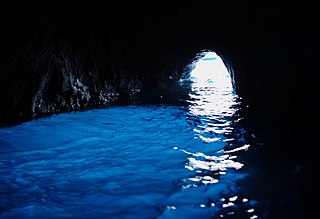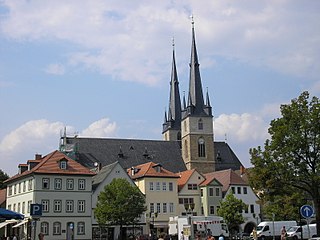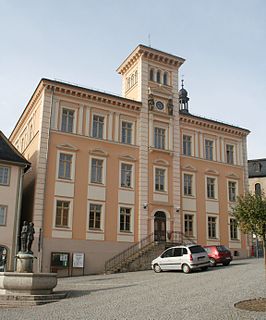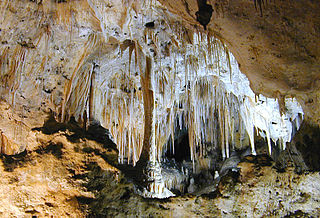
A stalactite (, ; from the Greek 'stalaktos' via stalassein is a mineral formation that hangs from the ceiling of caves, hot springs, or man-made structures such as bridges and mines. Any material that is soluble and that can be deposited as a colloid, or is in suspension, or is capable of being melted, may form a stalactite. Stalactites may be composed of lava, minerals, mud, peat, pitch, sand, sinter, and amberat. A stalactite is not necessarily a speleothem, though speleothems are the most common form of stalactite because of the abundance of limestone caves.

The Blue Grotto is a sea cave on the coast of the island of Capri, southern Italy. Sunlight passing through an underwater cavity and shining through the seawater creates a blue reflection that illuminates the cavern. The cave extends some 50 metres into the cliff at the surface, and is about 150 metres (490 ft) deep, with a sandy bottom.

Saalfeld is a town in Germany, capital of the Saalfeld-Rudolstadt district of Thuringia. It is best known internationally as the ancestral seat of the Saxe-Coburg and Gotha branch of the Saxon House of Wettin, which was renamed the House of Windsor during their British reign in 1917.

Treak Cliff Cavern is a show cave near Castleton in Derbyshire, England. It is part of the Castleton Site of Special Scientific Interest and one of only two sites where the ornamental mineral Blue John is still excavated. As part of an agreement with English Nature, the Blue John that can be seen in the show cave is not mined but it is extracted in small quantities from other areas of the cave and made into saleable items like bowls, jewellery and ornaments.

Schloss Altenstein is a schloss, or palace, upon a rocky hill on the south-western slope of the Thuringian Forest, not far from Eisenach, Thuringia, Germany. It was the summer residence of the Dukes of Saxe-Meiningen, and is surrounded by 160 hectares of English landscape garden, which contain, among other objects of interest, a cavern 300 metres long, through which flows a large and rapid stream.

The Jeita Grotto is a system of two separate, but interconnected, karstic limestone caves spanning an overall length of nearly 9 kilometres (5.6 mi). The caves are situated in the Nahr al-Kalb valley within the locality of Jeita, 18 kilometres (11 mi) north of the Lebanese capital Beirut. Though inhabited in prehistoric times, the lower cave was not rediscovered until 1836 by Reverend William Thomson; it can only be visited by boat since it channels an underground river that provides fresh drinking water to more than a million Lebanese.

Moaning Caverns is a solutional cave located in the Calaveras County, California, near Vallecito, California in the heart of the state's Gold Country. It is developed in marble of the Calaveras Formation. It was discovered in modern times by gold miners in 1851, but it has long been known as an interesting geological feature by prehistoric peoples. It gets its name from the moaning sound that echoed out of the cave luring people to the entrance, however expansion of the opening to allow access for the public disrupted the sounds. The portion of the cave developed for tourists consists of a spacious vertical shaft 165 feet tall, which is descended by a combination of stairs and a unique 100-foot-high (30 m) spiral staircase built in the early 1900s. It is open to the public for walking tours and spelunking. Including the off-trail areas, the cave reaches a depth of 410 feet.

Gräfenthal is a town in the district of Saalfeld-Rudolstadt in Thuringia, Germany.

Carlsbad Caverns National Park is an American national park in the Guadalupe Mountains of southeastern New Mexico. The primary attraction of the park is the show cave Carlsbad Cavern. Visitors to the cave can hike in on their own via the natural entrance or take an elevator from the visitor center.

The mines of Paris comprise a number of abandoned, subterranean mines under Paris, France, connected together by galleries. Three main networks exist; the largest, known as the grand réseau sud, lies under the 5th, 6th, 14th and 15th arrondissements, a second under the 13th arrondissement, and a third under the 16th, though other minor networks are found under the 12th, 14th and 16th for instance. The commercial product was Lutetian limestone for use as a building material, as well as gypsum for use in "plaster of Paris".

An underground lake or subterranean lake is a lake under the surface of the Earth. Such lakes may be associated with caves, aquifers, or springs. They are typically very low in salinity. Underground lakes often form in abandoned quarries, but can also form naturally. In most cases, naturally-formed underwater caves are an artifact of Karst topography.
Great Rutland Cavern is one of two caves at the Heights of Abraham, Matlock, Derbyshire, England. The other is Great Masson Cavern.

SAG/SDAG Wismut was a uranium mining company in East Germany during the time of the cold war. It produced a total of 230,400 tonnes of uranium between 1947 and 1990 and made East Germany the fourth largest producer of uranium ore in the world at the time. It was the largest single producer of uranium ore in the entire sphere of control of the USSR. In 1991 after German reunification it was transformed into the Wismut GmbH company, owned by the Federal Republic of Germany, which is now responsible for the restoration and environmental cleanup of the former mining and milling areas. The head office of SDAG Wismut / Wismut GmbH is in Chemnitz-Siegmar.

Cave of the Crystals or Giant Crystal Cave is a cave connected to the Naica Mine at a depth of 300 metres (980 ft), in Naica, Chihuahua, Mexico. It takes the form of a chamber within the limestone host rock of the mine, and is about 109-metre (358 ft) long with a volume of 5,000 to 6,000 cubic metres.

Morassina is an inactive mine in Schmiedefeld (Lichtetal), Thuringia, Germany. Today it is a tourist attraction known for its stalactites.

Gruta de Maquiné (MG-0243), also Lapa Nova de Maquiné, is the oldest and one of the most commercially visited caves in Brazil. It is located about 5 km (3.1 mi) from Cordisburgo and 143 km (88.9 mi) northwest of Belo Horizonte, in the State of Minas Gerais. The cave has seven huge chambers explored, amounting to 650 m (2,130 ft) (linear) and unevenness of the ground of only 18 m (59 ft). Safety measures like lighting, walkways and handrails allow a multitude of visitors to enjoy safely the wonders of the grotto where the whole journey is accompanied by an experienced local guide.

The Barbarossa Cave is an anhydrite cave in the Kyffhäuser Hills near Rottleben in the east German state of Thuringia. It is a cave with large caverns, grottos and lakes. The anhydrite has formed gypsum on the surface due to the air moisture in the cave and, as a result, has increased in volume. The resulting layers of gypsum gradually separate from the underlying rock and hang like wallpaper from the walls and ceilings of the caverns.
Nombre de Dios Grottoes is a cave system in the state of Chihuahua, Mexico. The main entrance of the cavern is located in the middle of the Cerro del Caballo of the Sierra de Nombre de Dios, approximately 200 m (660 ft)) from the Sacramento River, northeast of the state capital Chihuahua City. This elaborate cave system came to official attention during the sixteenth century. The location might have previously been used for ceremonial purposes by Apache, Comanche and others of the many local indigenous people.

The Nagórzyckie Grottoes in Tomaszów Mazowiecki – the former underground quartz sand mine in the southern part of Tomaszów Mazowiecki, Poland.
























